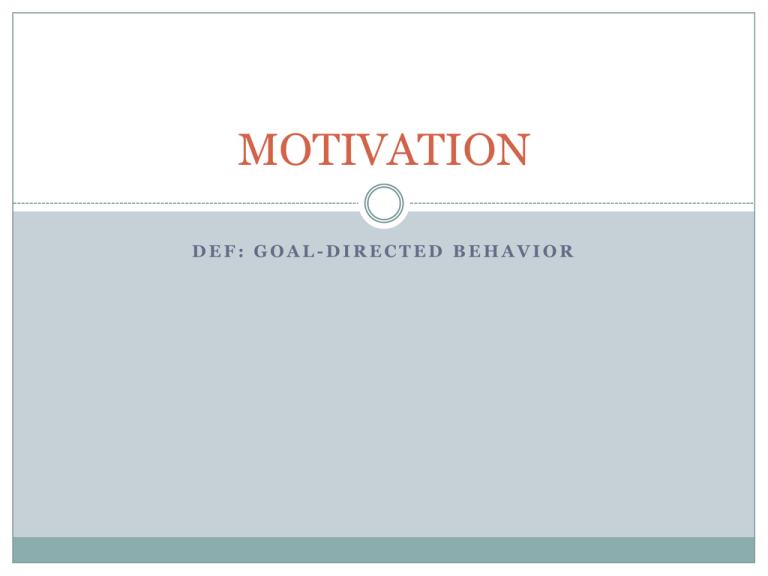
MOTIVATION
DEF: GOAL-DIRECTED BEHAVIOR
HUNGER---BRAIN REGULATION
Hypothalamus
Lateral hypothalamus (LH) triggers when to start
eating
Ventromedial nucleus of the hypothalamus (VMH)
triggers when to stop
Paraventricular nucleus (PVN) uses
neurotransmitters to regulate hunger
GLUCOSE REGULATION
Glucose is a simple sugar; an important source of
energy
Glucostatic theory: fluctuations in blood glucose
level are monitored by glucostats: neurons sensitive
to glucose in the surrounding fluid
Glucostats in the liver signal hypothalamus through
the vagus nerve
DIGESTIVE REGULATION
The stomach has 2 types of signal to inhibit further
eating:
1) vagus nerve monitors stretching of stomach wall
2) other nerves monitor nutrients in the contents of
the stomach
HORMONAL REGULATION
Insulin: secreted by the pancreas; must be present
for cells to extract glucose from the blood
Leptin: produced by fat cells; provide hypothalamus
w/info about body’s fat stores
ENVIRONMENTAL FACTORS IN
REGULATION OF HUNGER
Learned preferences and habits
Food related cues
Stress, arousal
EATING AND WEIGHT: ROOTS OF OBESITY
Obesity: the condition of being overweight
(exceeding ideal weight by 20%)
Health risks: cardiovascular diseases, diabetes,
hypertension, stroke, arthritis, and back problems
GENETIC PREDISPOSITION TO OBESITY
Adoption studies
Body mass index (BMI): weight (kg) divided by
height (m) squared
kg/m2
Genetic factors account for 61% of variation in
weight for men and 73% for women
CONCEPT OF A SET POINT
Set point: natural point of stability in body weight
Set point theory: body monitors fat-cell levels to
keep them fairly stable
SEX
SEXUAL MOTIVATION AND BEHAVIOR
HORMONAL REGULATION
Estrogens: principal gonadal hormones in females
Androgens: principal gonadal hormones in males
Increased levels of testosterone correlate w/higher
rates of sexual activity
PHEROMONES
DEF: a chemical secreted by one animal that affects
the behavior of another
Aphrodisiacs: substances thought to increase sexual
desire
There is no “Spanish Fly”
EROTIC MATERIALS
Pornography does not appear to incite overpowering
sexual urges
May alter attitudes toward sexual behavior
May create unrealistic expectations
ATTRACTION TO A PARTNER
Coolidge Effect: the preference for variety in sexual
partners seen in males of many species
Most species are selective
EVOLUTIONARY ANALYSES OF HUMAN
SEXUAL BEHAVIOR
Parental investment theory: the sex that makes the
smaller investment will compete for mating
opportunities with the sex that makes the larger
investment, and the sex with the larger investment
will tend to be more discriminating in selecting its
partners
EVOLUTIONARY ANALYSES
Human males are required to invest little
Females invest 9 months
Therefore females are selective with mates
GENDER DIFFERENCES IN PATTERNS OF
SEXUAL BEHAVIOR
Men think about sex more often
Men more motivated to have sex w/a variety
Men more likely to have sex w/someone they have
known for a short period of time
GENDER DIFFERENCES IN MATE
PREFERENCES
Males place more emphasis on youthfulness and
attractiveness
Females place more emphasis on intelligence,
ambition, income, and social status
GENDER DIFFERENCES IN RELATIONSHIP
JEALOUSY
Males of many species worry about paternity
uncertainty
Males will guard the female from other males
Sexual infidelity is threatening
Male emotional infidelity is threatening to females
MYSTERY OF SEXUAL ORIENTATION
DEF: a person’s preference for emotional and sexual
relationships with individuals of the same sex, the
opposite sex, or both
Heterosexual
Homosexual
Bisexual
SEXUAL ORIENTATION CONTINUED
Alfred Kinsey (1948, 1953) described sexuality as a
continuum---heterosexuality on one end,
homosexuality on the other
10% of the population could be characterized as
homosexual
ENVIRONMENTAL THEORIES
Freudian: homosexuality stems from being raised by
an ineffectual father and overprotective mother
Behaviorist: acquired through experience
Feminine boys and masculine girls tend to grow up
homosexual
BIOLOGICAL THEORIES
Research in the last 15 years has shown a biological
basis for homosexuality
Possible brain structure
INTERACTIONIST VIEW AND
SOCIOPOLITICAL IMPLICATIONS
Genes and hormones shape temperament that
ultimately shapes sexual orientation
Interactions w/peers solidifies arousal for same sex
Gays are still discriminated against
HUMAN SEXUAL RESPONSE
THE BIRDS AND THE BEES
EXCITEMENT PHASE
Muscle tension, respiration rate, heart rate, and
blood pressure increase rapidly
Vasocongestion: engorgement of the blood vessels
PLATEAU PHASE
Physiological arousal continues to grow, but at a
slower pace
Further vasocongestion
ORGASM PHASE
Orgasm: when sexual arousal reaches its peak
intensity and is discharged in a series of muscular
contractions that pulsate through the pelvic area
There are gender differences but they are extremely
similar in both sexes
RESOLUTION PHASE
Refractory period: a time following orgasm during
which males are largely unresponsive to further
stimulation
From a few minutes to hours---increases w/age




